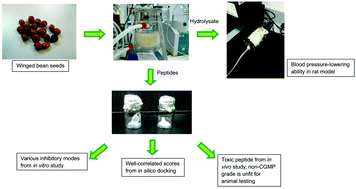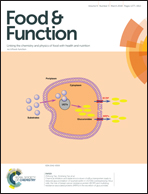Blood-pressure lowering efficacy of winged bean seed hydrolysate in spontaneously hypertensive rats, peptide characterization and a toxicity study in Sprague-Dawley rats
Abstract
Winged bean seed (WBS) is an underutilized tropical crop. The current study evaluates its potential to reduce blood pressure (BP) in spontaneously hypertensive rats and finds that it reduces BP significantly, in a dose-dependent manner. Five peptides with the sequences, RGVFPCLK, TQLDLPTQ, EPALVP, MRSVVT and DMKP, have been characterized in terms of their stability against ACE via in vitro and in silico modelling. All peptides exhibited IC50 values between 0.019 and 6.885 mM and various inhibitory modes, including substrate, prodrug and true inhibitor modes. The toxicity status of non-Current Good Manufacturing Practice (non-CGMP) peptides is evaluated and the results show that such peptides are toxic, and thus are not suitable to be tested in animals, particularly in repeated-dose studies. In short, WBS hydrolysate demonstrated in vitro ACE inhibitory properties and in vivo blood pressure lowering efficacy in rat models, fostering its potential as a functional food ingredient. Non-CGMP grade peptides are toxic and unfit for testing in animal models.



 Please wait while we load your content...
Please wait while we load your content...